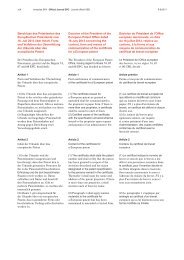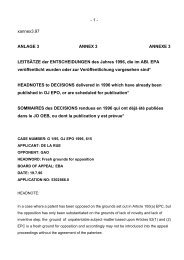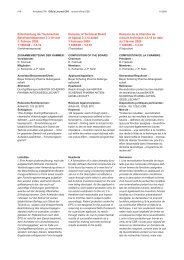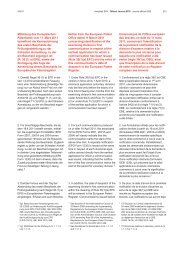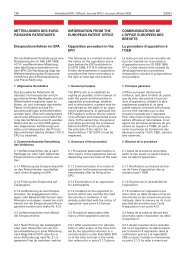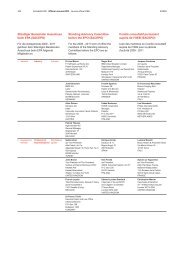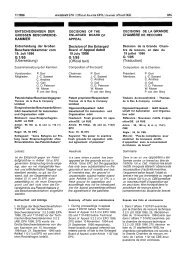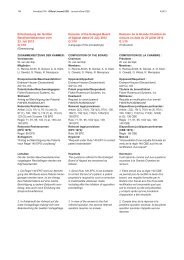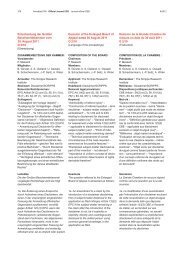Sonderausgabe 1 - European Patent Office
Sonderausgabe 1 - European Patent Office
Sonderausgabe 1 - European Patent Office
Create successful ePaper yourself
Turn your PDF publications into a flip-book with our unique Google optimized e-Paper software.
38<br />
<strong>Sonderausgabe</strong> Nr. 1 ABl. EPA / Special edition No. 1 OJ EPO / Edition spéciale n° 1 JO OEB<br />
d) die Wiedergabe von Informationen.<br />
(3) Absatz 2 steht der <strong>Patent</strong>ierbarkeit<br />
der dort genannten Gegenstände oder<br />
Tätigkeiten nur insoweit entgegen, als<br />
sich die europäische <strong>Patent</strong>anmeldung<br />
oder das europäische <strong>Patent</strong> auf diese<br />
Gegenstände oder Tätigkeiten als<br />
solche bezieht.<br />
Artikel 53<br />
Ausnahmen von der <strong>Patent</strong>ierbarkeit<br />
Europäische <strong>Patent</strong>e werden nicht erteilt<br />
für:<br />
a) Erfindungen, deren gewerbliche<br />
Verwertung gegen die öffentliche<br />
Ordnung oder die guten Sitten verstoßen<br />
würde; ein solcher Verstoß kann nicht<br />
allein daraus hergeleitet werden, dass<br />
die Verwertung in allen oder einigen<br />
Vertragsstaaten durch Gesetz oder<br />
Verwaltungsvorschrift verboten ist;<br />
b) Pflanzensorten oder Tierrassen sowie<br />
im Wesentlichen biologische Verfahren<br />
zur Züchtung von Pflanzen oder Tieren.<br />
Dies gilt nicht für mikrobiologische<br />
Verfahren und die mithilfe dieser<br />
Verfahren gewonnenen Erzeugnisse;<br />
c) Verfahren zur chirurgischen oder<br />
therapeutischen Behandlung des<br />
menschlichen oder tierischen Körpers<br />
und Diagnostizierverfahren, die am<br />
menschlichen oder tierischen Körper<br />
vorgenommen werden. Dies gilt nicht für<br />
Erzeugnisse, insbesondere Stoffe oder<br />
Stoffgemische, zur Anwendung in einem<br />
dieser Verfahren.<br />
Artikel 54<br />
Neuheit<br />
(1) Eine Erfindung gilt als neu, wenn sie<br />
nicht zum Stand der Technik gehört.<br />
(2) Den Stand der Technik bildet alles,<br />
was vor dem Anmeldetag der europäischen<br />
<strong>Patent</strong>anmeldung der Öffentlichkeit<br />
durch schriftliche oder mündliche<br />
Beschreibung, durch Benutzung oder in<br />
sonstiger Weise zugänglich gemacht<br />
worden ist.<br />
(3) Als Stand der Technik gilt auch der<br />
Inhalt der europäischen <strong>Patent</strong>anmeldungen<br />
in der ursprünglich eingereichten<br />
Fassung, deren Anmeldetag vor dem in<br />
Absatz 2 genannten Tag liegt und die<br />
erst an oder nach diesem Tag veröffentlicht<br />
worden sind.<br />
(d) presentations of information.<br />
(3) Paragraph 2 shall exclude the patentability<br />
of the subject-matter or activities<br />
referred to therein only to the extent to<br />
which a <strong>European</strong> patent application or<br />
<strong>European</strong> patent relates to such subjectmatter<br />
or activities as such.<br />
Article 53<br />
Exceptions to patentability<br />
<strong>European</strong> patents shall not be granted in<br />
respect of:<br />
(a) inventions the commercial exploitation<br />
of which would be contrary to "ordre<br />
public" or morality; such exploitation<br />
shall not be deemed to be so contrary<br />
merely because it is prohibited by law or<br />
regulation in some or all of the<br />
Contracting States;<br />
(b) plant or animal varieties or essentially<br />
biological processes for the production<br />
of plants or animals; this provision shall<br />
not apply to microbiological processes or<br />
the products thereof;<br />
(c) methods for treatment of the human<br />
or animal body by surgery or therapy<br />
and diagnostic methods practised on the<br />
human or animal body; this provision<br />
shall not apply to products, in particular<br />
substances or compositions, for use in<br />
any of these methods.<br />
Article 54<br />
Novelty<br />
(1) An invention shall be considered to<br />
be new if it does not form part of the<br />
state of the art.<br />
(2) The state of the art shall be held to<br />
comprise everything made available to<br />
the public by means of a written or oral<br />
description, by use, or in any other way,<br />
before the date of filing of the <strong>European</strong><br />
patent application.<br />
(3) Additionally, the content of <strong>European</strong><br />
patent applications as filed, the dates of<br />
filing of which are prior to the date<br />
referred to in paragraph 2 and which<br />
were published on or after that date,<br />
shall be considered as comprised in the<br />
state of the art.<br />
d) les présentations d’informations.<br />
2007<br />
(3) Le paragraphe 2 n’exclut la brevetabilité<br />
des éléments qu’il énumère que<br />
dans la mesure où la demande de<br />
brevet européen ou le brevet européen<br />
concerne l’un de ces éléments, considéré<br />
en tant que tel.<br />
Article 53<br />
Exceptions à la brevetabilité<br />
Les brevets européens ne sont pas<br />
délivrés pour :<br />
a) les inventions dont l’exploitation<br />
commerciale serait contraire à l’ordre<br />
public ou aux bonnes moeurs, une telle<br />
contradiction ne pouvant être déduite du<br />
seul fait que l’exploitation est interdite,<br />
dans tous les Etats contractants ou dans<br />
plusieurs d’entre eux, par une disposition<br />
légale ou réglementaire ;<br />
b) les variétés végétales ou les races<br />
animales ainsi que les procédés essentiellement<br />
biologiques d’obtention de<br />
végétaux ou d’animaux, cette disposition<br />
ne s’appliquant pas aux procédés microbiologiques<br />
et aux produits obtenus par<br />
ces procédés ;<br />
c) les méthodes de traitement chirurgical<br />
ou thérapeutique du corps humain ou<br />
animal et les méthodes de diagnostic<br />
appliquées au corps humain ou animal,<br />
cette disposition ne s’appliquant pas aux<br />
produits, notamment aux substances ou<br />
compositions, pour la mise en œuvre<br />
d’une de ces méthodes.<br />
Article 54<br />
Nouveauté<br />
(1) Une invention est considérée comme<br />
nouvelle si elle n’est pas comprise dans<br />
l’état de la technique.<br />
(2) L’état de la technique est constitué<br />
par tout ce qui a été rendu accessible au<br />
public avant la date de dépôt de la<br />
demande de brevet européen par une<br />
description écrite ou orale, un usage ou<br />
tout autre moyen.<br />
(3) Est également considéré comme<br />
compris dans l’état de la technique le<br />
contenu de demandes de brevet européen<br />
telles qu’elles ont été déposées,<br />
qui ont une date de dépôt antérieure à<br />
celle mentionnée au paragraphe 2 et qui<br />
n’ont été publiées qu’à cette date ou à<br />
une date postérieure.



